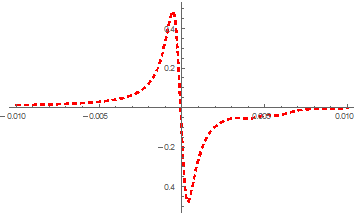I am having a problem with making a fit to data in Mathematica, which may involve my understanding of the methods available.
I am trying to fit the derivative of a Frota function (which is a Single Peak curve) together with two Gaussian Amplitudes.
In theory, the Frota function can be described as:
f[V_, phi_, gamma_, ek_, a_, b_, c_] :=
a*Im[E^(I*phi)*Sqrt[(I*gamma)/(V - ek + I*gamma)]] + b*V + c;
As you can see that is not a function that can be differentiated easily. First I tried to differentiated it in the following way:
df[V_, phi_, gamma_, ek_, a_, b_, c_] :=
D[ComplexExpand[f[x, phi, gamma, ek, a, b, c]], x] /. x -> V;
df[V, phi, gamma, ek, a, b, c]
In principle that works, but the function f has to be complex expanded before taking the derivative, due to the imaginary part not having a non numeric derivative. Moreover, when I plot the function, I have to take the real part. Still I get reasonable results and can fit my data with the function:
dfP2Gauss[V_, phi_, gamma_, ek_, a_, b_, c_, Agauss1_, Agauss2_,
Gcenter1_, Gcenter2_, gGauss1_, gGauss2_] :=
df[V, phi, gamma, ek, a, b, c] +
(c + Agauss1*E^(-0.5 ((V - center1)/ gGauss1)^2)) +
(c + Agauss2*E^(-0.5 ((V + Gcenter2)/ gGauss2)^2))
where I put some the Gaussian peaks in.
That does not look to bad, but when I start to fit my data (which consists of around 200 points), it takes like 40 minutes to do 100 iteration. Further, it gives bad results, because it makes the Gaussian peaks almost zero, even when I give good starting parameters. I also tried to make borders for the widths of the Gaussians, but then it just stays at the lower limit. Because of the incredible long caluculation time, I can't increase the iterations to say 1000, and even if did I don't it would help much. Maybe someone can help me?
Furthermore, I tried to calculate the derivative numerically:
numericfrota[V_, phi_, gamma_, ek_, a_, b_, c_, y0_] :=
ND[f[V, phi, gamma, ek, a, b, c], V, y0, Terms -> 30]
The calculation of the derivative now goes four times faster, but I can't plot it together with the Gaussians.
My code would be something like this:
numericGauss[V_, phi_, gamma_, ek_, a_, b_, c_, y0_, Agauss1_,
Agauss2_, Gcenter1_, Gcenter2_, gGauss1_, gGauss2_] :=
numericfrota[V, phi, gamma, ek, a, b, c, y0] +
(c + Agauss1*E^(-0.5 ((V - Gcenter1)/ gGauss1)^2)) +
(c + Agauss2*E^(-0.5 ((V + Gcenter2)/ gGauss2)^2));
But when I try to evaluate this, I need to give to specifications, y0 and V. They need to be the same and go from -0.01 and 0.01. But Mathematica just allows me to give one range, either y0 and V. If I choose to just take V and, therefore, derive the numeric Frota in respect of V at the point V, I just get a straight line. I just don't know how to properly adjust my functions.









dfwith some noise but didn't supply thephi,gamma,ek, etc, parameters you used. Could you supply those parameters? $\endgroup$